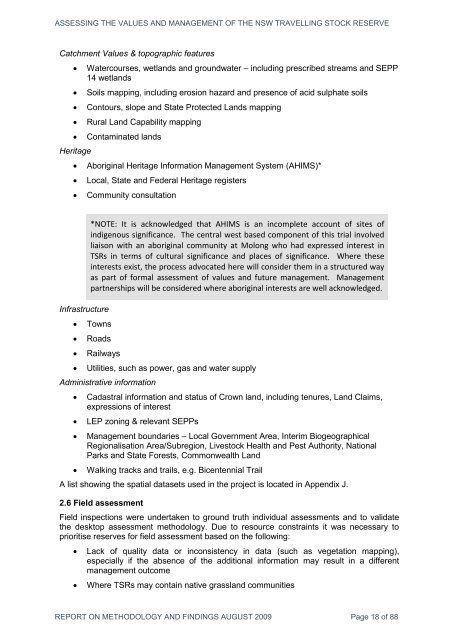Assessing e Values and Management of the NSW Travelling ... - Land
Assessing e Values and Management of the NSW Travelling ... - Land
Assessing e Values and Management of the NSW Travelling ... - Land
You also want an ePaper? Increase the reach of your titles
YUMPU automatically turns print PDFs into web optimized ePapers that Google loves.
ASSESSING THE VALUES AND MANAGEMENT OF THE <strong>NSW</strong> TRAVELLING STOCK RESERVE<br />
Catchment <strong>Values</strong> & topographic features<br />
• Watercourses, wetl<strong>and</strong>s <strong>and</strong> groundwater – including prescribed streams <strong>and</strong> SEPP<br />
14 wetl<strong>and</strong>s<br />
• Soils mapping, including erosion hazard <strong>and</strong> presence <strong>of</strong> acid sulphate soils<br />
• Contours, slope <strong>and</strong> State Protected L<strong>and</strong>s mapping<br />
• Rural L<strong>and</strong> Capability mapping<br />
• Contaminated l<strong>and</strong>s<br />
Heritage<br />
• Aboriginal Heritage Information <strong>Management</strong> System (AHIMS)*<br />
• Local, State <strong>and</strong> Federal Heritage registers<br />
• Community consultation<br />
Infrastructure<br />
*NOTE: It is acknowledged that AHIMS is an incomplete account <strong>of</strong> sites <strong>of</strong><br />
indigenous significance. The central west based component <strong>of</strong> this trial involved<br />
liaison with an aboriginal community at Molong who had expressed interest in<br />
TSRs in terms <strong>of</strong> cultural significance <strong>and</strong> places <strong>of</strong> significance. Where <strong>the</strong>se<br />
interests exist, <strong>the</strong> process advocated here will consider <strong>the</strong>m in a structured way<br />
as part <strong>of</strong> formal assessment <strong>of</strong> values <strong>and</strong> future management. <strong>Management</strong><br />
partnerships will be considered where aboriginal interests are well acknowledged.<br />
• Towns<br />
• Roads<br />
• Railways<br />
• Utilities, such as power, gas <strong>and</strong> water supply<br />
Administrative information<br />
• Cadastral information <strong>and</strong> status <strong>of</strong> Crown l<strong>and</strong>, including tenures, L<strong>and</strong> Claims,<br />
expressions <strong>of</strong> interest<br />
• LEP zoning & relevant SEPPs<br />
• <strong>Management</strong> boundaries – Local Government Area, Interim Biogeographical<br />
Regionalisation Area/Subregion, Livestock Health <strong>and</strong> Pest Authority, National<br />
Parks <strong>and</strong> State Forests, Commonwealth L<strong>and</strong><br />
• Walking tracks <strong>and</strong> trails, e.g. Bicentennial Trail<br />
A list showing <strong>the</strong> spatial datasets used in <strong>the</strong> project is located in Appendix J.<br />
2.6 Field assessment<br />
Field inspections were undertaken to ground truth individual assessments <strong>and</strong> to validate<br />
<strong>the</strong> desktop assessment methodology. Due to resource constraints it was necessary to<br />
prioritise reserves for field assessment based on <strong>the</strong> following:<br />
• Lack <strong>of</strong> quality data or inconsistency in data (such as vegetation mapping),<br />
especially if <strong>the</strong> absence <strong>of</strong> <strong>the</strong> additional information may result in a different<br />
management outcome<br />
• Where TSRs may contain native grassl<strong>and</strong> communities<br />
REPORT ON METHODOLOGY AND FINDINGS AUGUST 2009 Page 18 <strong>of</strong> 88

















